Abnormal chicken eggs. 37 egg and shell problems explained.

A guide to diagnosing egg problems and malformations for backyard chicken keepers.
Choose your egg problem from the table of contents. Email me if I have missed any out.
Table of Contents
- How to diagnose and treat 35 common egg and shell problems with chickens' eggs.
- How to identify which chicken is laying abnormal eggs:
- Are weird and odd eggs safe to eat?
- Multiple and double yolks:
- No yolk eggs:
- Undersized or tiny eggs:
- Worm infested eggs:
- Funny tasting or off flavoured egg:
- Eggs inside eggs:
- Blood stained eggs:
- Dirty or poop covered eggs:
- Shell-less eggs:
- Soft shelled eggs:
- Thin shelled eggs:
- Corrugated eggs:
- Blood or meat spots:
- Pale yolks:
- White yolks:
- Mottled yolks:
- Discoloured or off colour yolk:
- Green or coloured Albumin or egg white:
- Watery egg white:
- Tubes or curly shell ends:
- No membrane eggs:
- Salpingitis or Lash eggs:
- Wrinkled eggs:
- Misshapen eggs:
- Pimpled eggs:
- Calcium balls or bubbles on the shell:
- White patches, mottled or irregular egg shell colour:
- Suddenly speckled eggs:
- Body checked or internally cracked eggs:
- White banded eggs:
- Slab sided eggs:
- Pink or lilac eggs with excess bloom:
- Pale egg shells:
- Joined eggs:
- Cloudy whites:
- Eaten eggs:
- Conclusion:
How to diagnose and treat 35 common egg and shell problems with chickens' eggs.
Until you get to keeping your own flock of chickens you never get to see the egg oddities that backyard keepers get a steady stream off.
A considerable number of egg and shell issues have causes in common with each other, probably the most common ones being stress in the flock and poor nutrition.
If you are using ground water bear in mind it may have odd levels of some minerals which can cause imbalances and in extreme cases even be poisonous.
It's not uncommon to have a few unusual eggs especially if you have a flock of young birds that are starting to lay. Some lay the perfect egg from number 1 and other take a week or two to settle into the laying cycle.
Chickens will begin producing eggs when they are 20-24 weeks old. Their egg production peaks at around 32 weeks, and declines thereafter. Our hens are 2 years old and still producing at a good rate, so this decline isn’t necessarily dramatic.
The egg will form in the chicken’s body over 26 hours, before being laid. Chickens only lay eggs during the day – they are very responsive to daylight – and therefore they will typically lay their eggs later and later in the day, until they eventually skip a day, then start laying early in the morning again.
How to identify which chicken is laying abnormal eggs:
There is really only three ways to identify which chicken is laying a particular egg.
- Mark the vent of the bird with food colouring and see which egg is which colour.
- Trap nesting. This catches the bird as the enter the nest.
- Standing and watching them.
Below: An egg marked with colour streaks. A few drops of food colouring in the vent will mark the eggs for two or three days.
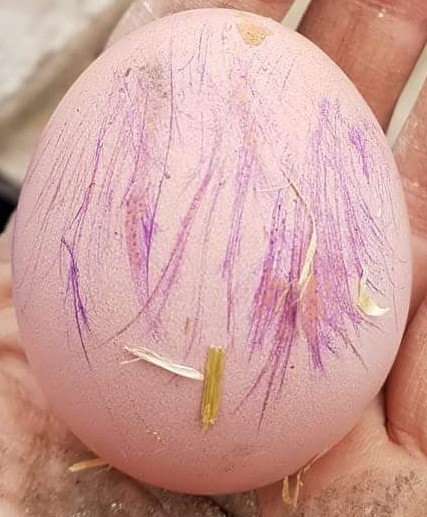
Avoid red food colouring, it can cause vent pecking.
Are weird and odd eggs safe to eat?
Some odd eggs are safe to eat and some are not. If you are unsure then do not.
Small eggs laid by young pullets are fine to eat, just you need more of them.
Banded and slab sided eggs are safe to eat provided the shell is intact. Meat spots are generally just picked out with a spoon
Avoid shell less and other odd flavoured or coloured eggs and throw them away.
A lot of weird eggs don't look appetising even if they are fine to eat, in this case scramble them and feed them back to the hens.
Multiple and double yolks:
Over the years I have eggs with two, three, four and six yolks in, but I've never had 5 yolks in one eggs before.
Below: A image of a three and a four yolked egg mixed in with two singles yolked eggs.

Interestingly when I had three, they were a joined pair of yolks and a single third one that was much larger than the other two. The times I had 4 and 6 they were all matched pairs of yolks.
There is no real issue with double or multiple yolks in eggs they are caused by rapid ovulation or a productive cycle that is not in sync. There are two types of double yolk, those that seem to have the contents of two separate eggs inside and those that seem to have a twin yolk that is part of a pair.
Double and multiple yolks tend to come from young hens just getting into lay or older birds that lay fewer but larger eggs. It seems to be an inherited trait but I was never able to breed a bird that laid double yolkers as a matter of course despite years of trying.
Multiple and double yolked eggs seem to be much more associated with high productivity hybrid strains although I have noticed that most birds produce the odd one over the course of their laying lives.
Apparently the record is 9 yolks in one egg.
As a rule the more yolks in an egg, the smaller they are.
It can be caused by chemicals and drugs that effect hormone levels.
No yolk eggs:
No yolked eggs are also called wind, dwarf or fart eggs and in the old days it was believed it was roosters that laid them. Sometimes also called witch eggs, fairy eggs or oops eggs.
Below: A no yolked egg.
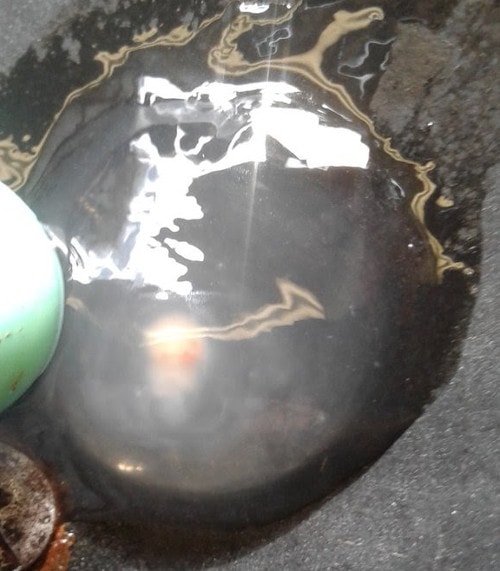
You can normally tell the cause, if it has a small meat spot or fleck in it then it is a piece of reproductive tissue that has been treated as a yolk by the oviduct. At some time I have had these from most of the types of poultry that I have kept including bantams, quail, ducks and guinea fowl.
Causes of no yolk eggs in chickens:
- Young pullets first eggs.
- Loose tissue in the oviduct getting packaged up as a small egg.
- Chemicals and drugs that effect hormone balance.
- Old chickens at the end of their laying cycle.
I have seen them laid as a pair where the first tiny egg contained only the white and the second only the yolk.
Treatment is time. Either the condition will resolve itself and egg production will return to normal or the bird will never lay proper eggs.
Undersized or tiny eggs:
Again small eggs are often a young pullets first efforts although they can be caused by stress in the flock. These are often just half or quarter sized versions of ordinary eggs and provided there is nothing wrong they are fine to eat as well.
Below: A tiny but complete egg next to a coin for comparison.
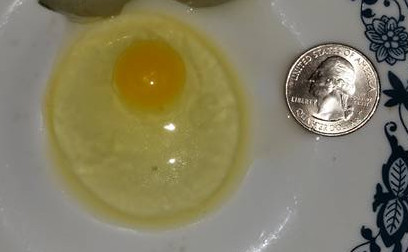
If you particularly like yolk then these eggs are often a treat as they are mostly yolk.
Below: 2 cooked tiny eggs that are 60% yolk.
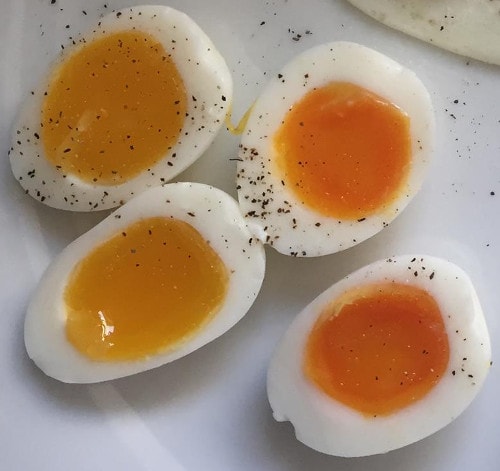
I love these small pullet eggs as I am a big fan of the yolk.
Treatment is to wait until normal sized eggs come along. I have had thousands of chickens over the years and only ever had one that laid small eggs all it's life.
Worm infested eggs:
Worm filled eggs are extremely rare but I have seen one once. They occurring only in hens with a high parasite load.
Below: An egg with worms.
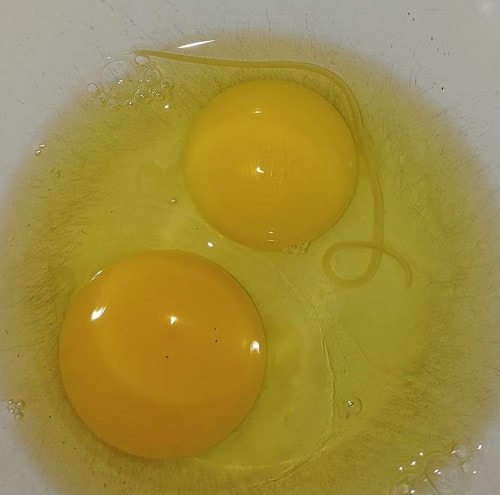
One of the reasons you don't tend to see them is that a bird with that sort of parasitic load will normally have stopped laying eggs and be quite ill.
It is more likely that what you think is a worm in your egg is actually a malformed chalazae. This is a quite normal twisted protein fibre that is part of the egg and sometimes it comes out straight.
Below: An egg with malformed chalazae that are straight and can look like worms.
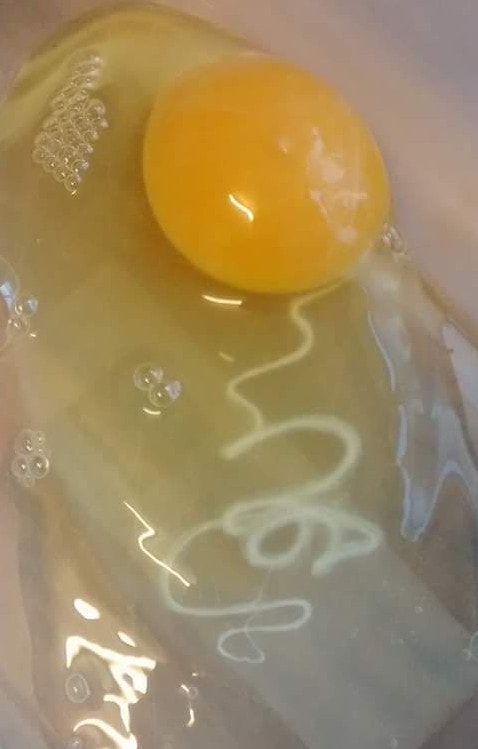
The function of the chalazae is too support the yolk in the centre of the shell and occasionally they don't twist up properly during formation.
Finding worms in eggs is not only a little disgusting but a also means that you haven't wormed your flock often enough.
Causes of worms inside eggs:
- High worm load and they get encased during egg production.
The worm you find inside chicken eggs is Ascaridia galli, a parasitic roundworm belonging to the phylum Nematoda. Nematodes of the genus Ascaridia are essentially intestinal parasites of birds.
A. galli is the most prevalent and pathogenic species, especially in domestic fowl. It causes ascaridiasis, a disease of poultry due to heavy worm infection, particularly in chickens and turkeys. It inhabits the small intestine, and can be occasionally seen in eggs.
Treatment is regular de-worming of all poultry.
Funny tasting or off flavoured egg:
Funny tasting or off flavoured eggs may result from chickens eating certain foods and by contamination from environmental odours.
Supposedly hens that eat onions and garlic can get garlic flavoured eggs but I have never seen this, it is more likely to come from storing your eggs and your onions or garlic next to eat other in the fridge or cupboard.
It has been said that fish meal and fish oil will lay eggs with an undesirable flavour but actually it was a feeding study that proved that the fishy taste in eggs was from seed oils in the diet like cotton-seed.
Eggs can easily absorb odours that translate into unpleasant flavours if they're stored near strong or volatile chemicals.
Treatment is to feed chickens a proper pelleted diet and avoid foods containing seed oils or treats causing the off taste in your eggs. Store eggs away from from strong tasting human foods.
Eggs inside eggs:
Eggs in side another egg can happen when an egg reverses direction in the egg tube or oviduct.
Over the years I have had several combinations where either both eggs were complete or a yolk or white was missing from one or the other.
Causes of eggs inside eggs:
- Stress
Sometimes one or other egg is missing a shell, just about any combination is possible.
Below: Eggs inside other eggs is quite rare.
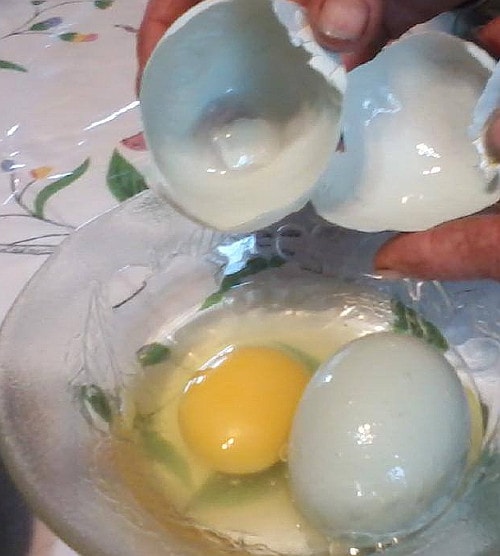
Treatment is time to allow normal egg production to resume. Most of the cases I can recall were associated with bad nighttime thunderstorms.
Blood stained eggs:
Eggs that are stained or smeared with blood are quite common in young pullets that are just coming in to lay but it does have other more sinister causes as well.
Causes of blood stained or smeared eggs:
- Prolapse of the cloaca.
- Vent pecking and cannibalism.
- Over weight and fat chickens.
- Sudden changes in day length.
- Injury.
Below: An egg with blood smeared on the shell.
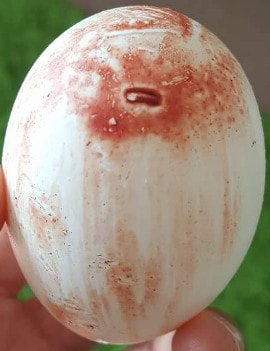
Bloody eggs should clear up in a day or two otherwise suspect one of the more sinister causes.
Treatment is initially time to allow the hen to get used to laying eggs otherwise monitor for pecking and bullying. See here for hens bleeding from their vents.
Dirty or poop covered eggs:
Dirty eggs can be caused by a couple a factors, some of which, like hens with muddy feet, are just a part of everyday chicken keeping.
Regularly getting eggs in the nest that have been smeared with or covered in chicken poop is a strong sign that there is a dietary problem with your flock.
Causes of poop covered eggs:
- Too much salt in the diet. This can happen if chickens get into pig feed or some human foods for example.
- Wet droppings.
- Too much fibre or indigestible feed-stuffs.
- Water supply problems or electrolyte imbalances.
- Poor gut health.
Below: Dirty eggs. not very nice and don't store well.
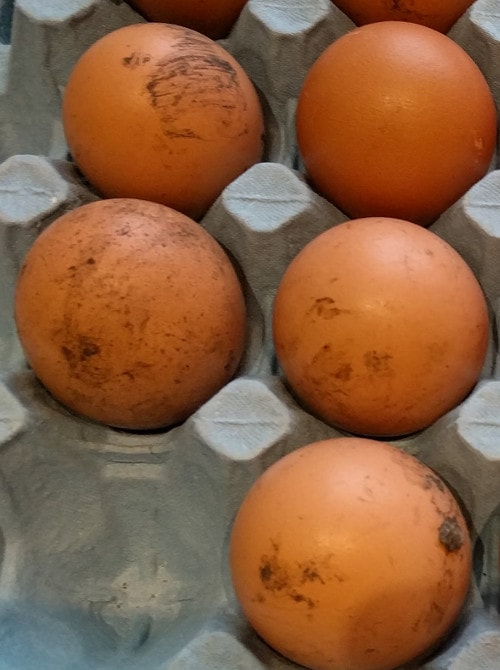
Shell-less eggs:
This is the rubbery egg with only the membranes to keep everything in place and no shell at all. It can happen as a "one off" or become common depending on the cause.
Probably the most common cause of shell-less eggs is in hybrid hens where the shell glands is still immature but they bird has started to lay.
Causes of shell-less eggs in chickens:
- Very young birds.
- Salt imbalances.
- Mycotoxins from mouldy feed.
- Several disease like Egg drop syndrome, Infectious bronchitis and Newcastle disease.
- Poor diet and lack of calcium, phosphorus or vitamin D.
- Stress.
Below: Here is an egg with no shell at all and just the membranes to hold it all together.
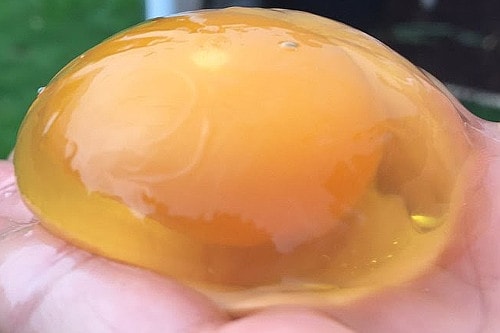
If the egg is a single one-off event the the treatment for shell less eggs is time, otherwise increase calcium and shell in the diet and remove stress factors from the flock. Check the pasture for mushrooms and make sure the chickens are not eating things they should not be. Avoid too much human food.
Soft shelled eggs:
Eggs with an incomplete shell or patchy shell that flakes off easily is probably most common with older hybrid hens or rescue ex battery hens.
The eggs may be complete and even have a powdery shell that rubs off easily. Soft shell eggs differ from shell less eggs in that you can't see the yolk inside.
Below: A soft shelled egg.
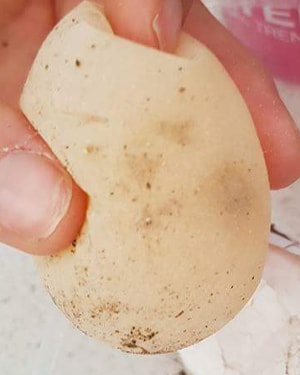
Causes of soft shelled eggs:
- Old hens.
- Hens have been in a long laying cycle.
- Heat stress.
- Mycotoxins from mouldy feed.
- Excess phosphorus in the diet.
- Lack of calcium.
- Salt and / or mineral imbalances.
Soft shelled eggs may still have quite a substantial amount of shell material on the egg, it just isn't bonded or laid down properly and lacks any strength.
For more on soft and thin shelled eggs.
Thin shelled eggs:
Thin shelled eggs differ from soft shell in that there is a very thin layer of shell that has been properly laid down over the egg.
This is a big problem when spent hens are rescued from farms and end up in the backyard. The birds are highly productive and have had a hard life and egg quality suffers.
Below: Thin shelled eggs may crack as they are laid or collected.
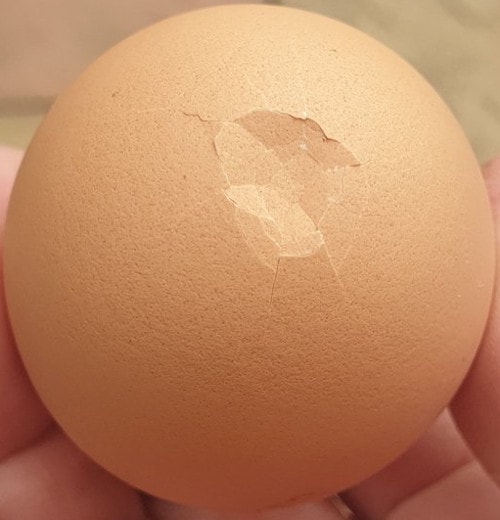
Also these birds are fed a special feed as an easily digestible flake and the transition to the backyard diet can cause egg problems like thin shells as their digestive system is not used to grinding down oyster shell to provide the hen with the calcium it needs. In the commercial environment calcium is added in powdered form to feed.
It is much less common in heritage hens. The problem ranges from thin hair line cracks to large holes
Causes of thin shelled eggs in chickens:
- Old or spent birds.
- Mycotoxins from mouldy feed.
- Salt and / or mineral imbalances.
- Heat stress causing over consumption of water.
- Poor diet and lack of calcium, phosphorus or vitamin D.
Treatment is to add calcium to the diet and remove stress factors from the flock. It may never resolve in old hens.
Corrugated eggs:
Corrugated eggs have characteristically rough and uneven shells and a surface that can resemble corrugated cardboard. This has often been associated with damage to the tubular shell gland or shell gland pouch from infection leaving either temporary or permanent damage to the that part of the oviduct.
The amount of distortion on the egg varies and it may be a single ridge or cover the whole surface.
Below: A corrugated egg.
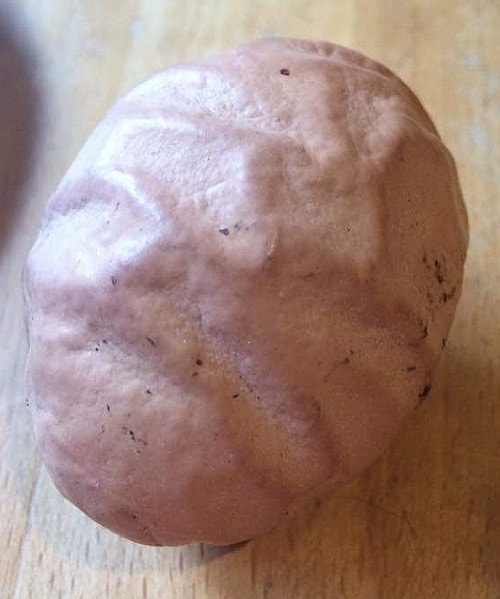
Causes of corrugated eggs in chickens:
- Diseases like Newcastle or Infectious Bronchitis.
- Excessive use of medications and antibiotics.
- Excessive calcium consumption.
- Inherited condition.
- Copper deficiency.
Treatment for corrugated eggs involves either treating the chicken, using the correct medication in the right amounts or correcting the dietary imbalances.
Blood or meat spots:
Blood or meat spots occur when blood or a bit of tissue is released along with a yolk. Each developing yolk in a hen's ovary is enclosed in a sack containing blood vessels that supply yolk building substances.
Blood spots tend to be smeared on the yolk while meat spots tend to float free in the egg white.
When the yolk is mature, it is normally released from the only area of the yolk sac, called the "stigma" or "suture line", that is free of blood vessels. Occasionally, the yolk sac ruptures at some other point, causing blood vessels to break and blood to appear on the yolk or in the white. As an egg ages, the blood spot becomes paler, so a bright blood spot is a sign that the egg is fresh.
Blood spots occur in less than one percent of all eggs laid. They may appear in a pullet's first few eggs, but are more likely to occur as hens get older, indicating that it's time to cull.
Blood spots may be triggered by too little vitamin A in a hen's diet, or they may be hereditary - if you hatch replacement pullets from a hen that characteristically lays spotted eggs, your new flock will likely do the same.
Below: Blood spot in a chickens egg.
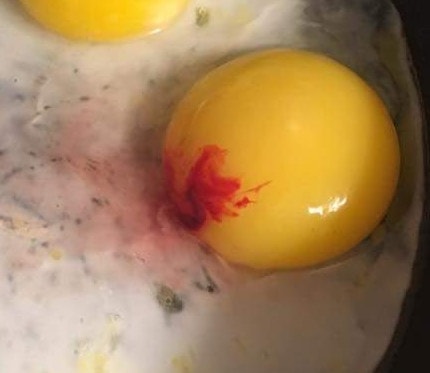
Meat spots appear as brown, reddish brown, tan, Gray or white spots in an egg, usually on or near the yolk. Such a spot may have started out as a blood spot that changed colour due to chemical reaction, or it may be a bit of reproductive tissue. Since meat spots look unappetising, cull a hen whose eggs characteristically contain them.
Below: Meat spot in a chickens egg.
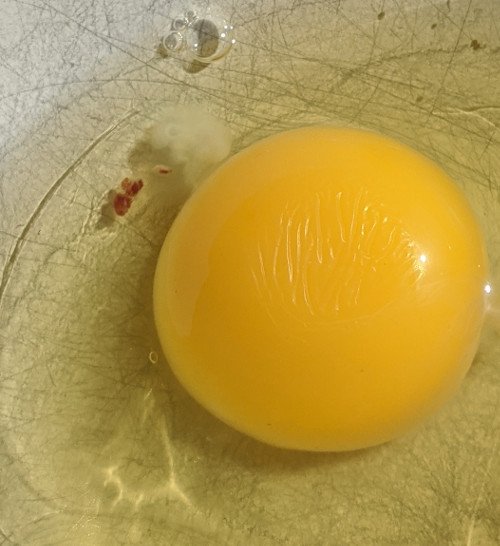
Meat spots are more common the darker the egg laid by the hen. Almost unseen in white eggs layers and more common in brown egg layers.
Pale yolks:
Pale yolks are a sign the bird is poorly nourished. Your feed may be old and stale but the birds are lacking red and yellow pigments they would normally get from green grass or coloured vegetables or flowers.
Modern hybrid hens tend to lay paler eggs that heritage types because they produce them faster.
Yolk colour should be anything between a pale yellow and a bright orange.
Below: Comparison between my backyard free range and store bought hybrid pale egg yolks.
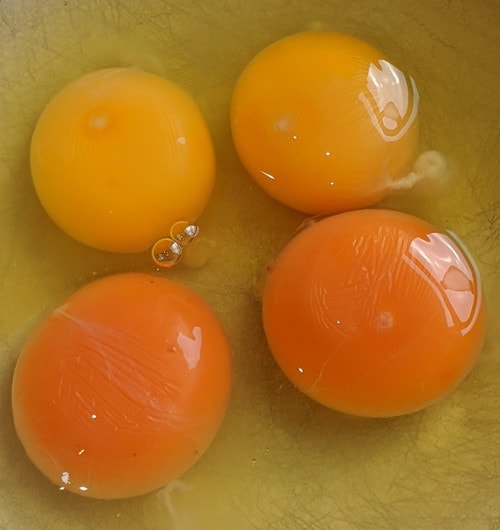
Treatment: Allow greenery and coloured feed in the diet. Marigold petals and turmeric are used commercially. Bell peppers and carrots can help.
White yolks:
Pure white yolks are a sign the bird may need to be wormed and the diet if the chicken assessed. A chicken that is otherwise healthy and still produced white yolked eggs may be genetically predisposed to and will always lay such an egg.
Below: An egg with a pure white or Platinum yolk. Pale yolks are quite common but pure white yolks are rare.
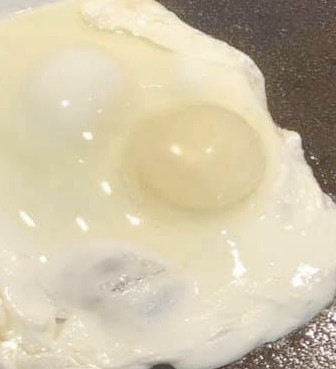
Pure white yolks are normally fine to eat but not very appetising to the eye.
The chickens may be eating a poisonous plant or ingesting mycotoxins from mouldy feed.
Mottled yolks:
The eggs yolks have a patchy appearance with areas of differing colour. Discard heat affected eggs. Hot days and improper storage can be dangerous for egg safety.
Below: A mottled yolk.
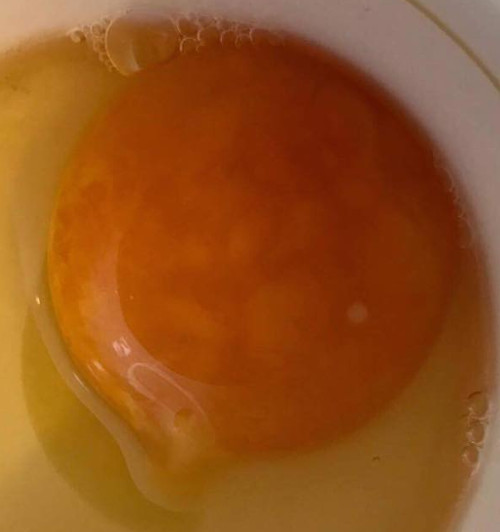
Crack open each egg into a bowl to inspect prior to using.
Mottled yolks in chickens are caused by:
- Worming drugs and compounds piperazine, dibutyltin dilaurate and citrate and the anticoccidial drug Nicarbazin.
- Heat stressed chickens
- Certain antioxidants such as gallic acid and tannic acid.
- Feeding hens raw soybean meal.
- Hereditary.
- Mineral and Calcium deficiency in the diet.
- High storage temperature
- Start of incubation in egg not collected quickly
Treatment for mottled yolks is to remove stress factors and improve diet and egg collection and storage.
Discoloured or off colour yolk:
Odd coloured for egg yolks include red, green and blue. They are caused by the chicken ingesting something they shouldn't have.
I mentioned below a story about a fisherman feeding leftover maggots to my chickens, this left them with bright red eggs throughout.
Below: A discoloured egg yolk.
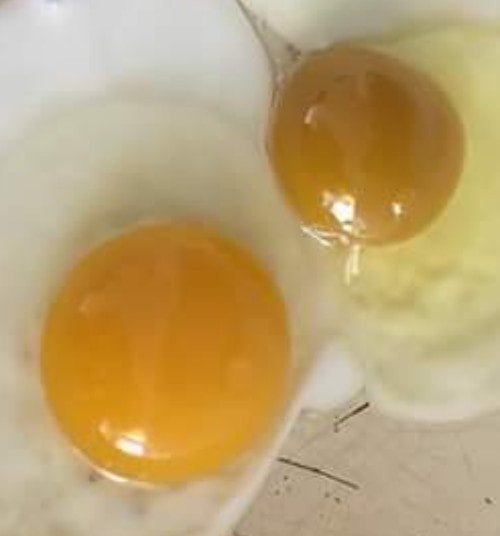
Ethylene glycol, more commonly known as the car radiator antifreeze additive can cause odd coloured eggs.
Off coloured yolks can be caused by large amounts of seed oils in the diet or from the ingestion of certain chemicals or velvet weed.
Green or coloured Albumin or egg white:
Some pigments used in feeds can cause egg staining. I had an incident where a fisherman was feeding his left over maggots to my hens without me knowing and the dyes used in the production of the maggots were getting into the eggs.
Some dyes from plants can get into the egg.
Below: Red staining can come from some feed additives and of course blood.

Infection from Pseudomonas bacteria produces a greenish, fluorescent, water soluble pigment in the albumen.
Over consumption of vitamins can produce some odd colours.
Ethylene glycol from cooling systems can cause colour problems.
Watery egg white:
All eggs have a watery egg white layer just inside the shell and in a normal eggs you can see this as a kind of thin skirt around the more solid egg white that encompasses the yolk.
Below: These two eggs both have watery albumin.
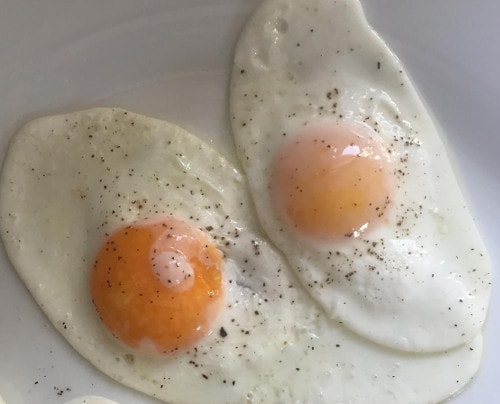
Eggs with thin watery whites are common when they have been stored for long periods.
In my experience hybrids tend to produce eggs with more watery whites than rare breed or heritage varieties.
Causes of watery egg whites in chickens:
- Old poorly stored eggs.
- Old hens.
- Several disease can cause poor quality eggs.
- High ammonia levels from poop in the coop.
- Heavy metal poisoning.
- Salt imbalances.
Treatment for watery egg whites is better husbandry and clean water.
Tubes or curly shell ends:
Eggs are laid with a curl of shell at one end. It can be anything from a short raised lump to a 3 inch long curly tube that looks like the egg has grown a tail.
Below: A egg with a curly shell or tube like tail.
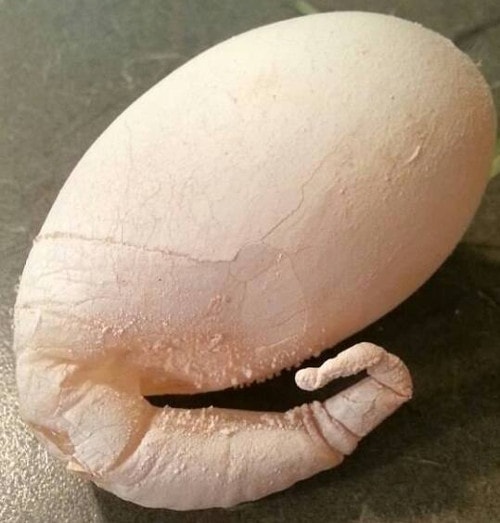
Curly or tube eggs are often laid with thin flaky shells.
Causes of curly and tubular eggs:
- Stress
- Defective shell gland.
- Sudden changes in day length.
- Disease. Egg Drop Syndrome is known for causing egg problems.
If the egg is a one-off it can be ignored. Make sure the chicken is well and not stopped laying through loss of condition.
No membrane eggs:
Sometimes seen as a broken egg in a nest with no membranes and I have seen one case where a hen just laid a yolk. It is not common and as long as it is a one-off then there is nothing to worry about.
Below: A membrane-less egg in the nest. Just the yolk and a splodge of albumin.

The lack of shell means it wasn't eaten by a chicken. It is causes by the failure of the section of the oviduct that lays down the protein fibre membranes.
The only time I have seen it was when a hen escaped from a fox and then went on to dump that in the nest a few hours later.
Salpingitis or Lash eggs:
Lash Eggs, Salpingitis or Egg Lash Disease in chickens is the inflammation of the oviduct, is a serious reproductive-related emergency frequently seen in the hens especially bred for high productivity.
There are many causes of Salpingitis. It can be found in other species such as ducks and geese. It can be bacterial or viral origin, and the co-infection of Escherichia coli and tetra trichomonas (protozoa) can happen in ducks.
Below: Lash eggs can take many forms but are formed as exudes and pus from infections pass down the oviduct and are subject to the egg production process.
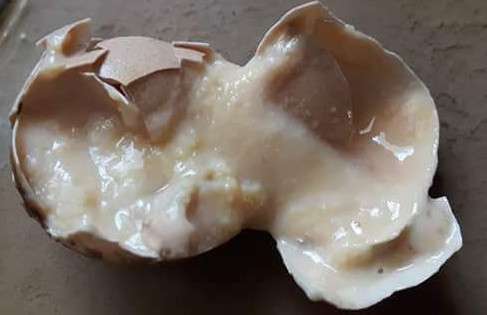
Salpingitis can bring about reduced egg production and is most often due to either Mycoplasma gallisepticum, Escherichia coli, Salmonella or Pasteurella multocida (fowl cholera) infection in the bird.
Below: Lash eggs take many forms.
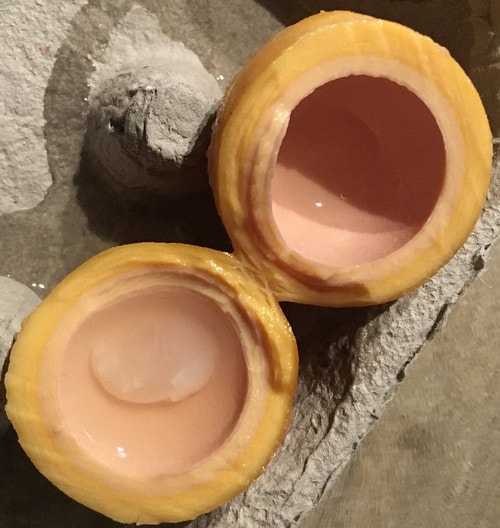
Older chickens are more likely to suffer but the net result is the production of one or more "Lash-Eggs"
Lash eggs are disgusting and smell bad and are an indication immediate treatment is required.
Lash eggs may have a shell or just be encased in membranes. For a complete in depth guide to lash eggs and Salpingitis in chickens.
Wrinkled eggs:
Wrinkled eggs are different from corrugated ones, the lines are more like tight folds in the shell. There may be only one or several and they may run around or along the length of the egg. These tend to be caused by stress or disease.
Below: Wrinkling in the egg shell.
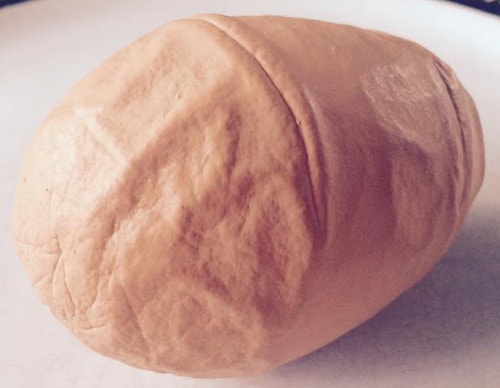
Causes of wrinkled eggs in chickens:
- Stress.
- Infectious Bronchitis.
- Oviduct infection.
- Over crowded chickens.
- Defective shell gland.
Wrinkled eggs may be okay to eat, it depends on the cause. Treat the underlying infection and improve flock stress.
Misshapen eggs:
These differ from normal egg in size or shape. The classic representation is the appearance of a small or very large egg in the nest or one that is unusually elongated.
Below: An elongated egg.

If it is a one off occurrence then it is likely nothing to worry about but anything that happens for more than 3 days in a row will benefit from investigation.
Causes of misshapen eggs in chickens:
- Stress and over crowding.
- Newcastle disease, Infectious Bronchitis or egg drop syndrome.
It's not uncommon to see a few of these if your hens are disturbed by a bad thunderstorm in the night for example.
Pimpled eggs:
Pimpled eggs look like they have small eruptions in the surface of the shell. They are small hollow lumps of calcium that hasn't been laid down properly on the shell. The result often flakes under mild pressure when handling. I have heard pimpled eggs being likened to sandpaper.
Below: Pimpled eggs. Looks like blisters in the shell.
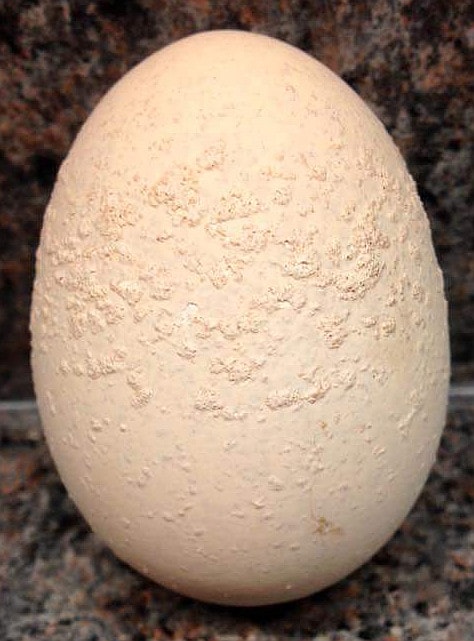
- Old or spent chickens.
- Hereditary.
- Inadequate nutrition.
- Mineral imbalance.
Treatment is to replace the flock or improve the diet.
Calcium balls or bubbles on the shell:
The eggs are laid with patches of little balls attached only by the bloom that are easy to rub off. They can occur in quite large patches and are common in young pullets and early season eggs.
Below: Eggs show up with little round balls of calciun in patches.
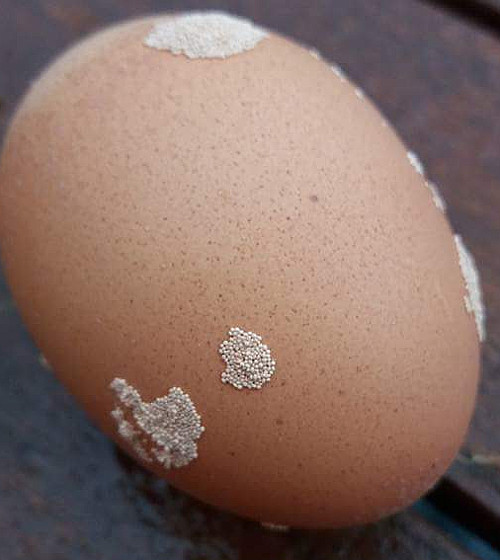
The issue settles down quite quickly as a rule although some hens go on producing eggs like this for months. It is rarely a problem and not normally anything you need to worry about.
Below: The excess calcification on the egg shell in close up.

So if your chickens lay an egg with a sand-like deposit on it that brushes off easily and leaves no mark on the egg and the egg inside seems normal then it will be fine and you need only keep an eye on the birds in question.
This is essentially an over active egg shell gland and the movement of the egg in the duct rounds the balls up and gathers them in one spot.
White patches, mottled or irregular egg shell colour:
Mottled eggs sometimes have a powdery feel to the shell. If you candle them they appear to have thin patches in the shell that might look like the content of the egg are beginning to leak out.
Below: A mottled egg shell.

Cause is normally stress, disease or dietary.
Suddenly speckled eggs:
It is quite normal for some breeds to lay speckled eggs but if a hen starts doing it there may be something wrong with the oviduct.
Below: A suddenly speckled egg.

Speckles can be white or brown and of varying sizes and may be clusters at one or other end of the egg,
The cause for suddenly speckled eggs in chickens is a defective shell gland pouch.
Body checked or internally cracked eggs:
These are eggs that have gotten cracked during the calcification process in the shell gland. The result is a ridge where the shell has been repaired before it is laid. This often happens when hens are knocked or banged about by overly amorous roosters.
Below: An internally cracked and repaired egg.
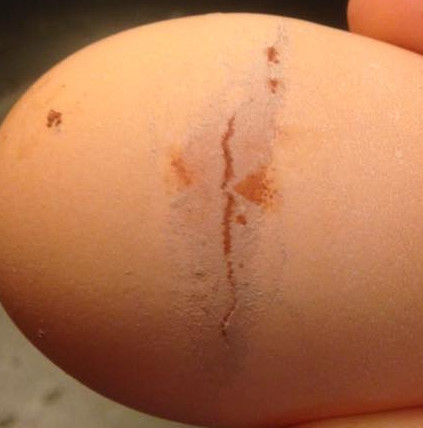
There may be various stages to the repair, some still appear cracked and the new layer is very thin and some have a large and noticeable ridge around the egg.
Cause of broken and mended eggs in chickens:
- Injury.
- Stress from overcrowding.
- Too many roosters.
White banded eggs:
White banded eggs are the result of two eggs touching the in the shell gland pouch.
The result of this is the first egg gets excess calcium deposited on it's surface and the second egg gets a slab side (see below) and looks like it has shrunk a bit.
Below: White banded egg.
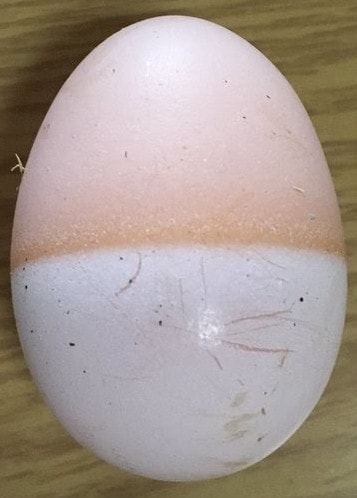
The excess calcium shows up as a white band and can be in any orientation depending on exactly where in the oviduct the eggs come together.
Causes of banded eggs in chickens:
- Young hybrids first eggs.
- Stress.
- Disease.
- Drastic changes in lighting.
There is no real treatment except to remove stress, the problem will either go away or it won't.
Slab sided eggs:
Slab sided eggs are often laid as a counterpart to the white banded eggs (see above) and they both have the same causes.
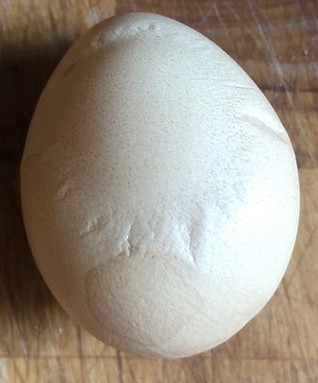
Below: A slab sided egg.
Causes of slab sided eggs in chickens:
- Young hybrids first eggs.
- Stress.
- Disease.
- Drastic changes in lighting.
Treatment is time and the issue will most likely correct itself.
Pink or lilac eggs with excess bloom:
The egg appears to be a pink colour because of the thick layer of cuticle or bloom laid down on the shell.
Some hens have been bred and selected for this and sometimes this happens a lot with the first eggs of the season until birds get going.
Causes of excess bloom on chicken eggs:
- Stress.
- Excess calcium in the diet.
Pale egg shells:
The colour of eggs a chickens produces are dependant on the breed, health and stress levels, the length of time the chicken has been in lay and the diet.
Sudden changes in the shell colour can indicate problems. The colour of the shells fade over time.
Suddenly pale egg shells may be caused by:
- The age of the chicken.
- The stress in the flock.
- The length of time the bird has been in lay.
- Exposure to some chemicals and drugs.
- Egg drop syndrome - EDS 76.
- Infectious Bronchitis (IB).
The pigment on the shell may be patchy or have bands and may take on a gray hue.
Joined eggs:
Two eggs joined together by a tube, one or both may have soft or missing shells.
It may be that two eggs have come together in the oviduct of a young hen.
Below: An example of joined eggs.
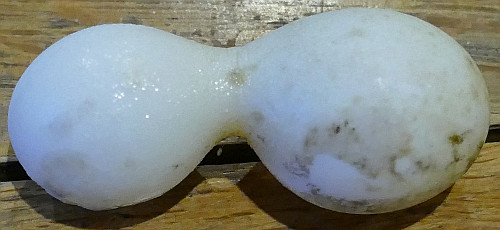
Caused by two eggs coming together inside the oviduct and in some case one side may contain the yolk and the other side the white.
The thickness of the tube varies considerably and you may get two eggs with tails rather than a pair of joined up ones.
Cloudy whites:
Cloudy whites are common in eggs that have just been laid and have yet to cool.
Below: Cloudy egg whites.
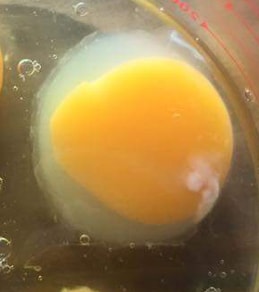
It is simply gas in the egg white that would diffuse out to form the air sac in the end of the egg as it cools. You can eat these without any problems at all.
Eaten eggs:
Chickens sometimes eat their own eggs - take a look at this for the reasons and the fix.
Conclusion:
More than 1 egg problem can occur at any one time as many have similar causes.
A chicken has to be healthy and reasonably low stressed to be producing eggs, so if you aren’t getting eggs, thinking about the general chickens’ health is your first step.
The Oyster Shells I referred to in a previous post are provided to get the chickens the calcium they need to form eggs shells.
When eggs are laid, you want to collect them as quickly as is convenient.
